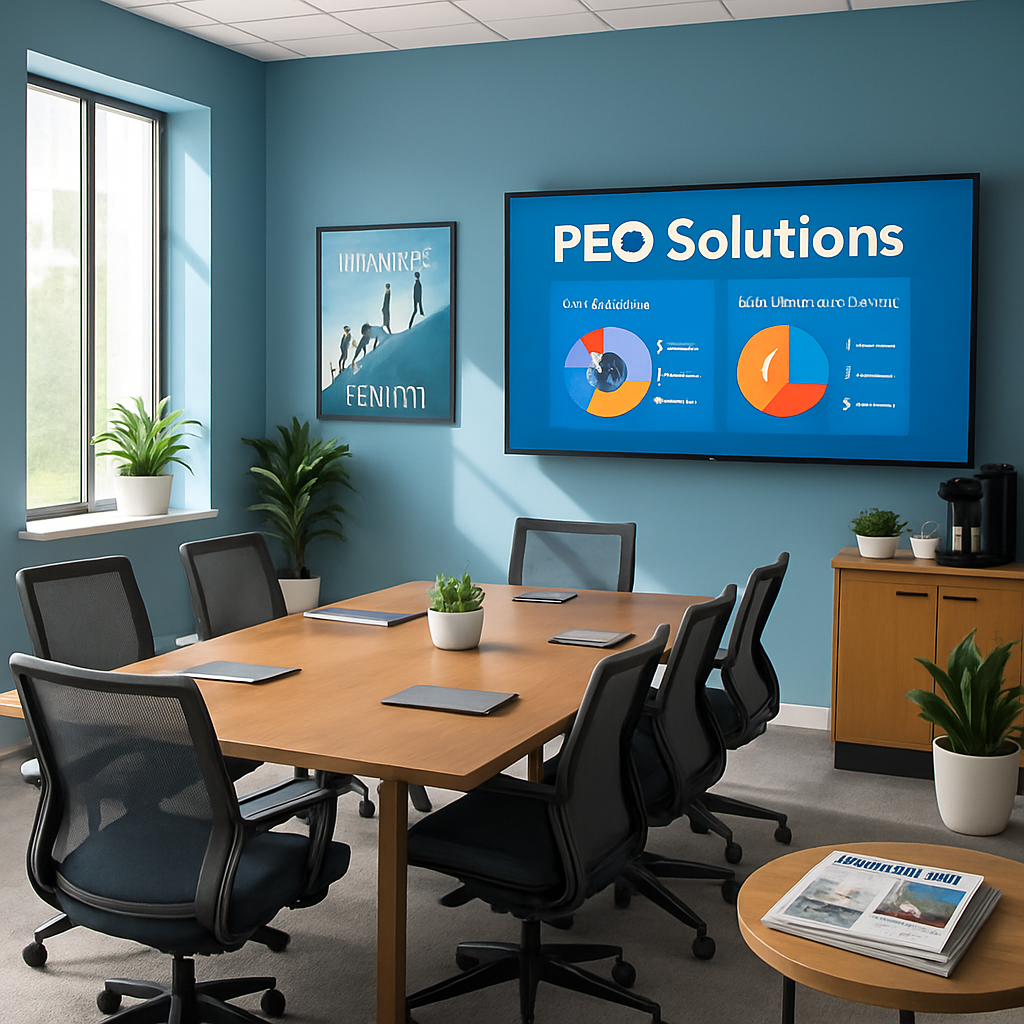The EaseBlog: Risk Management

What is a PEO? Everything You Need to Know
Professional employer organizations (PEOs) have been one of the best-kept secrets of SMBs - until now. According to a study by the National Association of Professional Employer Organizations, 98% of small to mid-sized business owners report they would enthusiastically recommend the service to peers.
But what exactly are PEOs, and why are they creating so many happy clients?
In short, PEOs provide integrated HR solutions so companies can focus on their core mission. They combine a large corporation's experience and expertise with a local partner's agility and care. PEOs handle everything from payroll and benefits to compliance and training, allowing businesses to get strategic human resources support. There’s a reason PEOs have a sky-high satisfaction rate.
Now that we’ve defined PEOs at a high level let’s explore how they work and why partnering with one could be a game-changer for your organization.
What does a professional employer organization do?
PEOs are like a Swiss army knife for human resources - they provide a full suite of HR solutions tailored to meet each client's needs. By partnering with a PEO, companies gain access to a wide range of strategic services including:
HR Administration
From payroll processing to benefits management, PEOs comprehensively handle critical HR administration tasks so companies can focus on operations and growth. This administrative relief alone is why many organizations partner with a PEO.
Risk Management & Compliance
With intricate laws related to workers’ compensation, unemployment insurance, harassment policies, and more, staying on top of the latest legislation is challenging for any HR department. PEOs have specialized teams to ensure clients follow all regulations, helping mitigate compliance infractions and legal risks.
Talent Development
A strong workforce is at the core of any successful organization. Many PEOs have training resources, and eLearning courses to invest in employee growth. This helps nurture talent, skills and leadership capabilities.
Analytics & Benchmarking
PEOs provide workforce analytics on compensation, retention, performance, and other metrics to help make data-driven business decisions. Some also benchmark key indicators against industry standards so companies can stay competitive.
This wide range of strategic service offerings enables clients to customize plans matching their unique HR needs and business goals.
Why should businesses partner with a PEO?
There are many advantages to partnering with a PEO. Here are some of the top reasons organizations use them:
Access to Cost-Efficient Benefits
PEOs can leverage size to negotiate discounted rates on group health insurance, dental, vision, 401(k) plans, Flexible Spending Accounts (FSAs), and more by pooling employees under a co-employment agreement (see below for more on co-employment).
This allows even small businesses to offer robust benefits. You also get access to the PEO’s workers’ compensation plan. Using a PEO's plan can lower your premiums if you have a history of claims. In addition, the PEO will handle yearly audits and the upfront deposit. That means your workers’ comp is on a “pay-as-you-go” basis.
Relief from Burdensome Administrative Tasks
PEOs take over payroll processing, tax filings, compliance issues, managing benefits, employee handbooks, and other intensive HR administration tasks. This frees up time and resources to focus on core business goals.
HR Compliance
With expertise in regulations like Family and Medical Leave Act (FMLA), Americans with Disabilities Act (ADA), Equal Employment Opportunity Commission (EEOC) regulations, OSHA rulings, and more, PEOs ensure clients follow all employment laws. This reduces compliance infractions and legal risks like fines or lawsuits.
Scalability and Workforce Flexibility
PEOs make it easy to scale up or down as business needs change. They enable quick hiring for growth or seasonal demands. Downsizing and layoffs are handled smoothly as well.
Access to Technology, Analytics and Insights
PEOs provide access to HR software, workforce analytics, and benchmarking data that most small businesses couldn't afford on their own.
Improved Employee Development and Retention
PEOs invest in employee growth through training programs, leadership development, mentorships, and access to learning management systems. This nurtures talent and loyalty.
Enhanced Safety
PEOs ensure safety programs adhere to OSHA and industry regulations. They also assist with critical processes like workers’ comp, unemployment insurance, and labor relations compliance.
Increased Employee Engagement and Satisfaction
PEOs can implement employee feedback surveys and address areas needing improvement. Higher engagement leads to improved retention and productivity.
Stronger Employer Brand and Recruiting
PEOs refine recruitment marketing and provide applicant tracking systems to strengthen talent attraction efforts. This enhances a company's employer brand.
Reduced HR Costs
By consolidating HR functions under a PEO umbrella, costs are reduced compared to hiring specialized in-house staff.
With so many advantages, it's easy to see why partnering with a PEO is a game-changer for organizations of all sizes and industries. Now that we've covered the immense value PEOs provide, let's explore exactly how the PEO model works.
How do PEOs work?
A unique co-employment structure is at the heart of the advantages of a PEO. Under this arrangement, the PEO is the employer on record for any HR-related responsibilities like taxes, compliance, etc. Essentially, many of the intricate administrative and legal requirements shift to the PEO's purview.
However, it's important to note that clients maintain complete control over the leadership and management of their business. The PEO does not replace the client's ownership or disrupt day-to-day operations. Personnel decisions, workforce direction, culture, and business strategy remain entirely under the client's oversight.
The PEO simply handles those critical HR functions in the background, providing incredible value to clients.
For example, the PEO will be responsible for payroll tax filings, procuring employee benefits, ensuring compliance with regulations like FMLA or ADA, and providing workers' compensation coverage. However, the client continues to lead the organization as they did previously.
In summary, PEO co-employment agreements allow companies to offload burdensome administrative tasks and compliance responsibilities while preserving their agility and independence.
What pricing models do PEOs use?
Regarding PEO pricing, clients encounter two primary models: paying a percentage of payroll or a flat per employee per month (PEPM) fee.
With percentage of payroll pricing, the PEO's fees vary each month based on the total payroll amount. Typically pricing is calculated as a percentage range of gross payroll, such as 3-8%.
In contrast, the PEPM pricing model charges a fixed flat rate per employee per month, regardless of payroll size. This fee remains static unless the number of employees changes.
Both models have their own pros and cons depending on your specific needs and situation. Understanding these two pricing structures helps inform which option may be preferential when evaluating PEO partners.
Percentage of Payroll Pricing
With this model, PEO fees scale up or down each month based on the client's payroll size. Some key factors include:
- The fee is calculated as a percentage of gross payroll, typically 3-8%.
- The percentage may vary based on services used, industry, risk profile, and the PEO agreement.
- As payroll increases or decreases, the PEO's fee adjusts proportionally.
- Clients only pay for services rendered based on that month's labor expenditure.
- Provides flexibility for businesses with fluctuations in headcount.
Pros of Percentage of Payroll Pricing:
- Fees scale directly with usage and payroll volume each month.
- Avoid overpaying in months with lower labor expenditure.
- Only pay for services actually used based on payroll size.
- Provides flexibility for businesses with seasonal fluctuations.
- Costs dynamically align with HR workload.
Cons of Percentage of Payroll Pricing:
- Fees directly rise if payroll costs increase.
- Less predictable budgeting due to variability.
- Administrative complexity of frequently changing fees.
PEPM Pricing
In contrast, the PEPM pricing model works as follows:
- Clients pay a flat, fixed fee per employee per month.
- The fee remains static regardless of payroll size.
- Fees stay the same even if fewer services are required some months.
Pros of PEPM Pricing:
- Consistent, fixed pricing provides predictable budgeting.
- Fees don't automatically increase if payroll rises.
- Simpler to administer with static monthly fees.
Cons of PEPM Pricing:
- Lacks flexibility for businesses with fluctuating labor.
- Fees remain unchanged even if fewer services needed.
- Can overpay in months with lower HR workload.
The optimal pricing model depends on each company's unique priorities and situation.
What are the alternatives to a PEO?
Some companies consider handling HR in-house or using more limited vendors instead of partnering with a PEO. However, these alternatives have downsides that make PEOs a better choice:
In-House HR Team
Building an internal HR team requires immense investment in specialized talent, technology, and infrastructure just to get off the ground. PEOs provide these solutions efficiently and cost-effectively. Relying on generalist HR staff also increases risks as they lack expertise in key areas like compliance, safety protocols, training systems, and labor relations. Fines and lawsuits become much likelier without the depth of a PEO's specialists. And scalability is limited to the bandwidth of that in-house staff.
Administrative Services Organizations (ASOs)
Administrative service organizations focus specifically on payroll and benefits administration in an á la carte model. But this misses the full spectrum of services PEOs provide, ultimately costing more than bundled PEO solutions that offer everything HR under one roof. Critical capabilities like compliance guidance, employee relations, recruiting assistance, safety programs, and workforce development are significant gaps compared to a PEO partnership.
Payroll Processing Firms
Outsourcing payroll processing checks the box for paycheck preparation but lacks the benefits administration, liability coverage, HR strategy, and compliance that PEOs encompass. Since payroll is already in PEO bundles, outsourcing it alone doesn't tend to provide cost savings either.
In summary, alternatives to PEOs ultimately leave gaps, increase risks and costs, and provide less value. When it comes to comprehensive HR, PEOs are the superior choice. Now let's clear up some common misconceptions.
How do you choose the right PEO?
Selecting the ideal PEO partner depends on your organization's needs and priorities. Here are some tips for thoroughly evaluating PEOs:
1. Review Service Offerings - Compare each provider's capabilities to find the best match for your particular HR needs. Look for expertise in critical areas important to your business.
2. Compare Pricing Models - Understand the pros and cons of PEPM versus percentage of payroll pricing to determine the optimal structure. Also, consider minimums, fees for add-ons, and contract terms.
3. Verify Industry Expertise - Ensure the PEO has substantial experience and clients in your industry vertical. This provides more tailored insights and services.
4. Check Client Retention - High client retention rates over many years indicate strong satisfaction with partnerships. This demonstrates the PEO's commitment to service.
5. Confirm Licenses and Compliance - Reputable PEOs will have the necessary operating licenses, insurance coverage, legal compliance, and HR expertise. Review financial stability as well.
6. Research Reviews - Feedback from current and past clients provides valuable third-party insight into the PEO's services, support, and capabilities.
7. Assess HR Technology - Determine if the PEO's payroll systems, HRIS, applicant tracking, and other technology integrate well and meet your organization's needs.
8. Vet Implementation Process - Ideally, the transition and onboarding to the new PEO should be quick and smooth. Ask about detailed steps and timelines.
Evaluating providers using criteria like this helps ensure you find the ideal PEO for your specific human resources needs and business goals.
PEOs as Your Solution to HR Drama
PEOs deliver enterprise-level administration, compliance, benefits, technology, and strategic support without the overhead required to staff these areas internally. If you already have in-house HR professionals, they can focus on core priorities rather than administrative burdens like payroll.
By following the guidance provided on pricing models, implementation, and evaluating providers, you can confidently find the ideal PEO match for their needs.
The bottom line is that PEOs are a game-changer, allowing you to relieve your biggest HR burdens while tapping into best-in-class support. Partnering with a PEO provides peace of mind that proven experts cover all your complex human resources needs.
Blog Categories
- PEO (21)
- Employees & Culture (13)
- Risk Management (8)
- HR Outsourcing (7)
- Human Resources (6)
- Workers' Comp (6)
- Compliance (5)
- Payroll (5)
- PAGA (4)
- Benefits (3)
- Flexible Spending Account (3)
- Podcasts (3)
- Diversity (2)
- HR technology (2)
- Training (2)
- ASO (1)
- Healthcare Savings Account (1)
- Inclusion (1)
- Legal Updates (1)
- PTO (1)
- SB 553 (1)
- Special Districts (1)
- recruiters (1)
- staffing (1)
Subscribe Here!
Let us help streamline the way you manage HR.

Subscribe for our the latest news and legal updates that will affect your business.
Newsletter Sign Up
Contact Us
Get in touch with us today.




